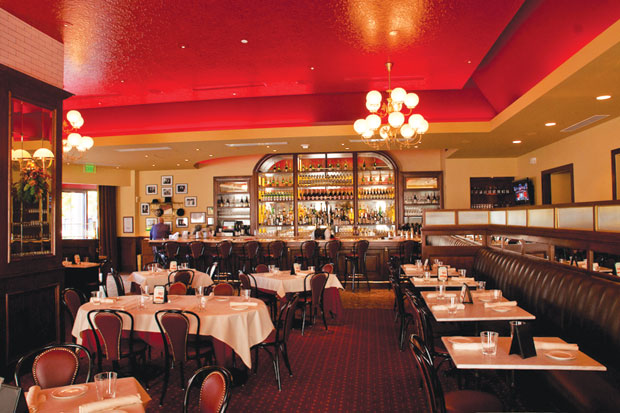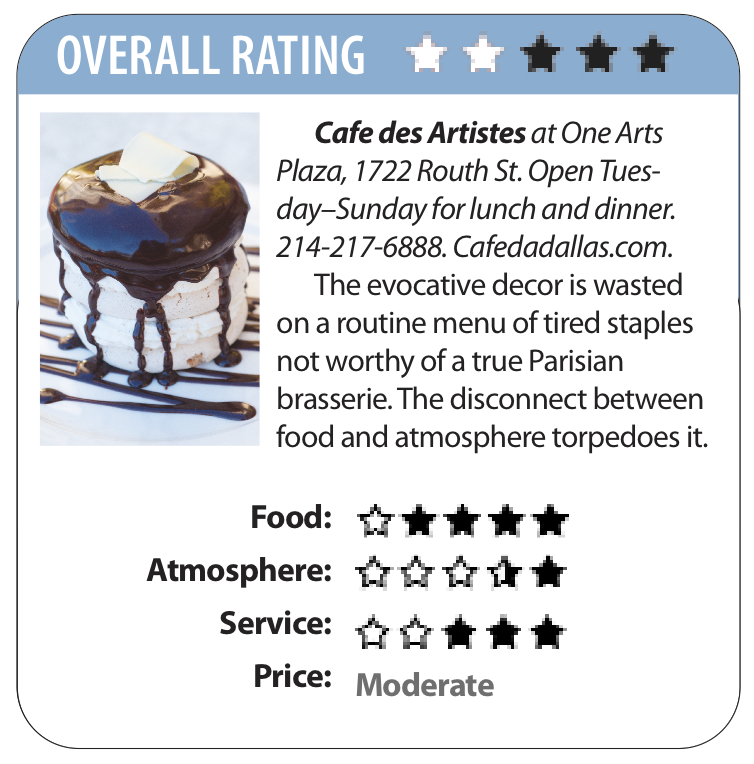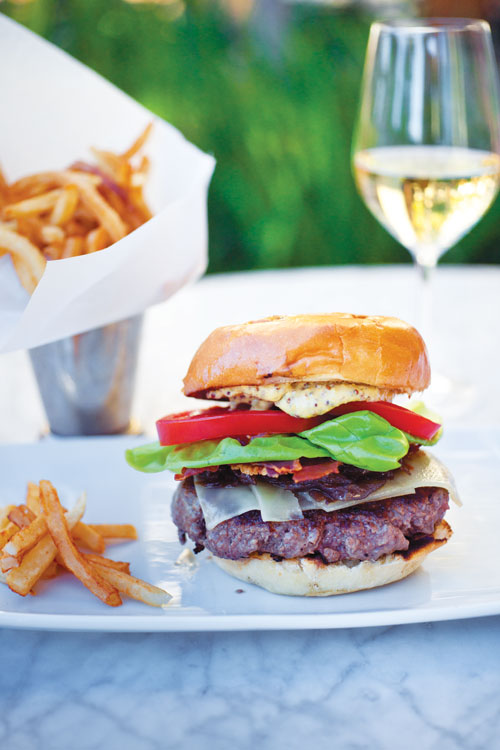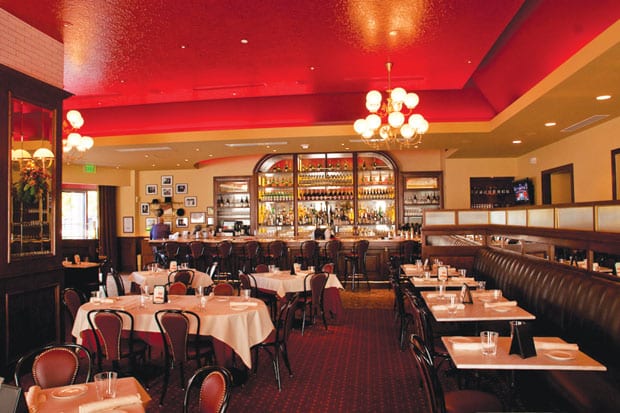Cafe des Artistes in One Arts Plaza has the look of a Parisian brasserie. So where is the cuisine to match?

LA BELLE EPOQUE | From mirrored banquettes to Chinese red as rich as the Moulin Rouge, Cafe des Artistes looks like a page from French history … it just doesn’t taste like one.
ARNOLD WAYNE JONES | Life+Style Editor
 Ah, Paris during La Belle Epoque: Petticoat-clad ladies dancing le can-can at the Moulin Rouge, Jules Cheret posters dotting streetlamps and alleyways with vibrant colors, music from concertinas drifting on winds fragranced with freshly-baked baguettes and paté from countless brasseries.
Ah, Paris during La Belle Epoque: Petticoat-clad ladies dancing le can-can at the Moulin Rouge, Jules Cheret posters dotting streetlamps and alleyways with vibrant colors, music from concertinas drifting on winds fragranced with freshly-baked baguettes and paté from countless brasseries.
Of course, it’s not like that anymore. Concertina music has been replaced by hip-hop blaring from over-sized headphones, the smell of automotive carbon smothers the aroma of bread and Benetton ads have replaced burlesque shows.
But the cafés? Well, the cafés remain, with their banks of narrow doors, small tables perched on tiled floors and espresso being pressed as diners share a morning cigarette or an evening aperitif. The era may have ended, but the iconography remains.
And that’s what Café des Artistes, the newest concept from Dallas restaurateur Alberto Lombardi, seeks to capture.
He’s chosen a suitable locale for this style: The corner space of One Arts Plaza on the eastern end of the Downtown Arts District, a suite formerly occupied by Screen Door. It’s well suited for the image Lombardi is trying to conjure: A buzzy refuge for food and wine prior to a night of theater or opera or strolling through the museums. Location has never been better served.
The décor accomplishes exactly what the name and position shoots for: Accessible glamour, courtesy of the late 19th century (and Dallas designer Ron Guest).
The banquettes are lushly appointed with mirrored headrests; the scarlet bunting is scandalous and rich; the bar resembles something from a Manet of the Folies-Bergére. There’s even a piano when live music is deemed appropriate, and the bar is stocked with fodder for old-school cocktails, including absinthe.
It’s everything you need to feel transported across time and space to an age of carefree indulgence.
Until the food arrives.
Lombardi’s restaurants are among the most reliable for well-priced, classic dishes of particular regions. His Taverna serves wonderful pizzas and some deft pastas; La Fiorentina, the recently closed Tuscan steakhouse, grilled up dandy meats; Sangria, his tapas diner, does Spanish plates authentically. Even Uptown’s Café Toulouse — in tone and style, a close sister to Café des Artistes — has served French bistro fare like you’d find in Paris.
Or rather, it used to. On my last visit to Toulouse, the filet was ragged and overcooked; the vegetables lacked freshness and color. I attributed it to a misstep, but now wonder if it might be indicative of bigger problems.
Nothing we tried at Café des Artistes was as inedible as that filet, but neither was it anything worth ordering a second time.

FRENCH-AMERICAN DIPLOMACY | Who goes to a brasserie for a hamburger, anyway — even if you call it a cafe burger?
The biggest puzzle: Why bother designing a brasserie if all you serve are well-trod items available widely elsewhere? Mac and cheese — really? Pastas and risottos are certainly available at a French café, but are more Roman than Parisian; where are the cassoulets, the croques madames? The menu lacks personality and variety. It screamed its tired ideas at every glance.
Escargot is technically offered, though the presentation is fricassee style (why?); you can order a soufflé, but you can do that at Toulouse and countless other places; and the charcuterie platter at Boulevardier trounces the one here.
Consider the “crispy meatball” app with “angry” tomato sauce ($9). The sauce does impart a slight kick, but “angry?” More like “inconvenienced” — perhaps “moody.” The meatballs themselves, generously put, possess a slight crunch, but are so smothered in the sauce that the descriptor “crispy” borders on misstatement. A lunch offering called the café burger ($13) benefits from a dollop of Dijon and a schmear of gruyere, but why seek out a burger here?
A side of Brussels sprouts with bacon ($5) sounded like something we could get many places, but we ordered it anyway. Again, they were not disastrous. But in a time where sautéed sprouts have become a staple at many gourmet eateries, the version here — firm but not grilled; they could use a burn, if only so that bacon clings better to them — fell below the norm.
Entrees let us down as well. The tagliatelle usually arrives Bolognese style, but we took a chance on the special, ordering it fruitti di mare ($22) — a mélange of shrimp, mussels and other bites of seafood. The pasta itself was not al denté, which may have been forgivable were the shrimp not overcooked. Blah.
The lobster risotto ($19) should have been a slam-dunk, but ours was an air ball. Tiny bits of lobster were in evidence, but didn’t define the dish. The risotto itself had all the seasoning of rice cake: Where were the herbs touted on the menu? I had to add table salt four times, and even then it had all the character of soggy cardboard. Shaved parmesan on top imparted some flavor on the spoonfuls where it was present, but risotto begs to have a cheesy overtone; this was defiantly lacking.
Desserts ($8 apiece) were a marginal improvement, at best. While the Mozart — a tiered tower alternating between stiff meringue and chantilly creme, doused in ganache — was exactly the dichotomy of light and heavy we expected, the opera cake was less melodious. “Pepperidge Farm,” declared my dining companion after a few bites of the confection of sponge cake and chocolate. Exactly right.
Even our wines were disappointing. Yes, yes, reds are to be served at “room temperature,” but that means a wine cellar in the north of France in the autumn, not a Dallas patio in July. The syrah ($11) and South American malbec ($9) may have been tasty, but came to us too warm, and before the food. I don’t blame servers for sub-par dishes, but they should know when the wine is the wrong temp and has come out too early.
The pre-theater crowd delivers energy on weekend nights (surely that’s a target audience), and the vibe is exactly what the décor demands. But until the food matches the concept, Café des Artistes feels more like a convenient way to bide one’s time, not a place to go to make an evening feel complete. If it weren’t for the décor, this restaurant seems about as evocative of French dining as a hot dog at the ballpark.
This article appeared in the Dallas Voice print edition March 15, 2013.

